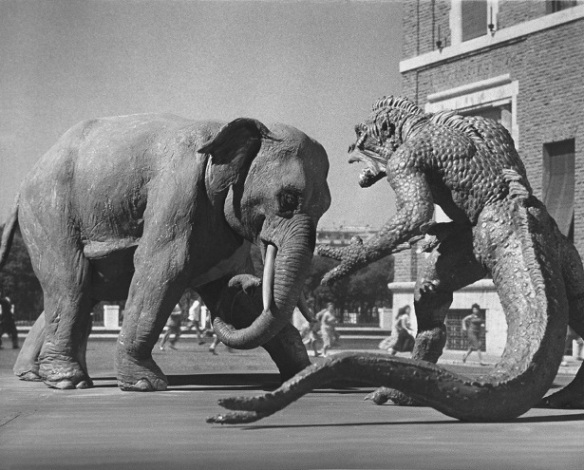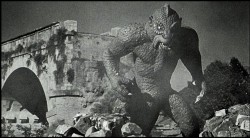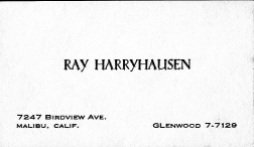Part of the “Keep Watching the Skies” Blogathon from Cinematic Frontier – Click on logo at right to see more entries of 50’s sci-fi classics!
20 Million Miles to Earth
directed by Nathan H. Juran
produced by Charles Schneer
Special effects by Ray Harryhausen
starring:
William Hopper
Joan Taylor
Frank Puglia
A US rocket returning from Venus crashes near a fishing village in Italy. Before it sinks beneath the waters depths, a young boy finds a strange figure encased in a gelatinous egg. He trades it to a zoologist and the next day it hatches an amazing little creature. However, this is the 1950’s so rest assured it won’t be ‘little’ for long; it will grow to monstrous proportions. It’s a testament to the amazing work of Ray Harryhausen that the directors of his films are mostly forgotten, but his name and his work lives on. He created a unique creature for this film, part reptilian, part humanoid and part alien, taken from its natural habitat to fend for itself in a strange new world.
Stop-motion animation from Harryhausen (as well as Willis O’Brien) was not Claymation. They did not use clay. They used a metal armature with movable joints, like a skeleton. It was then covered with foam and latex rubber enabling it to hold detail and fixed markings while maintaining flexibility for lifelike movement. For mammals the artists would add hair. You couldn’t get such good detail and movement with clay. Some stop-motion animation involved clay, (Gumby) and others involved wooden puppets (Rankin Bass holiday specials). However, Ymir was made with the aforementioned rubber layers and molds over skeletal design. Another big aspect to the magic of stop-motion monster films (one that it shares with Toho’s suitmation effects) is the building of miniature sets. You will see actors running down the street on location, then the monster chasing them on that same street. However, that same street is a miniature version in a studio for which the stop-motion filming can be conducted upon.
rubber layers and molds over skeletal design. Another big aspect to the magic of stop-motion monster films (one that it shares with Toho’s suitmation effects) is the building of miniature sets. You will see actors running down the street on location, then the monster chasing them on that same street. However, that same street is a miniature version in a studio for which the stop-motion filming can be conducted upon.
Ymir’s humanoid expressions manipulated by the talented and patient hands of Harryhausen, gave the creature empathy. We see shock, disappointment, anger, fear, desperation, all within the reactions of the beast; wide eyes, roars, hand and arm gestures, posture, all used to communicate without words. Because of this, most who see the film feel sad for Ymir’s demise, cringing at the sound of gun shots that bring him down. Ymir’s fight with a zoo elephant brought a special realism to the film and a sense of scale. Ray’s self-drawn storyboards choreographed a tense battle that intercut real elephant footage with his own recreation of the huge mammal. This was perhaps the greatest creature battle since Kong fought the T. Rex some 25 years previous. Shadows of Ymir will show up in later Harryhausen  creatures, the body is similar to his Cyclops in The 7th Voyage of Sinbad and his face is similar to the Kraken from Clash of the Titans. The wonderful long tail seems like a prerequisite for the snake-like Medusa. As with most 50s sci-fi/horror, there is a sub-plot following a budding romance concerning, Colonel Robert Calder, the only survivor from the space mission, and the zoologist’ s daughter, Marisa, played by the lovely Joan Taylor.
creatures, the body is similar to his Cyclops in The 7th Voyage of Sinbad and his face is similar to the Kraken from Clash of the Titans. The wonderful long tail seems like a prerequisite for the snake-like Medusa. As with most 50s sci-fi/horror, there is a sub-plot following a budding romance concerning, Colonel Robert Calder, the only survivor from the space mission, and the zoologist’ s daughter, Marisa, played by the lovely Joan Taylor.
Charles Schneer was a good friend to Harryhausen and an advocate for his fine craft, working with him on nearly a dozen films. This was Ray’s fourth film depicting giant monsters rampaging through cities. The first was his work under his mentor, Willis O’Brien in Mighty Joe Young. Following that was Beast from 20,000 Fathoms, and It Came from Beneath the Sea. Ray and Charles Schneer would move into fantasy adventure films after this, depicting mythological figures in his Sinbad films and other tales of ancient lore.
To younger generations, stop-motion FX doesn’t seem so real. That was part of the charm for our generation. We knew there was an art involved with making these beasts come to life. These FX artists didn’t just copy motions and images from real animals and put it into the creature’s digital repertoire. They infused the model’s movements with their own personality and mannerisms. It’s like the difference between a digital photo of a human face and the Mona Lisa. The Mona Lisa isn’t perfect and that’s what makes her so. That’s what gives her soul and personality. You can sense Ray’s soul and personality through these films, the creator, the adventurer, the craftsman, and the boy with wide eyed wonder at endless possibilities.
They recently digitally colorized the film and it looks like they did a decent enough job. However, I still prefer to watch it in b&w, the way Ray made it.
Once again, be sure to check out the Keep Watching The Skies Blogathon for more 50’s movie classics!
Parlor of Horror’s ‘Creature Feature’ reviews




























































